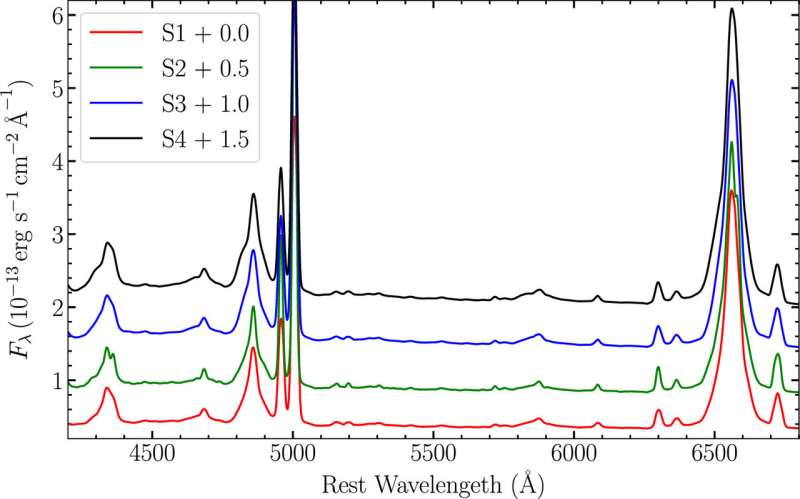
December 27, 2024 by Li Yali, Chinese Academy of Sciences
Collected at: https://phys.org/news/2024-12-reveal-geometry-kinematics-broad-line.html
Dr. Feng Haicheng from the Yunnan Observatories of the Chinese Academy of Sciences, along with his collaborators, has made progress in studying the geometrical and kinematical evolution of the broad-line region (BLR) in active galactic nuclei (AGN). The study was published in The Astrophysical Journal.
AGNs are among the universe’s most luminous objects, powered by the accretion of matter into supermassive black holes (SMBHs) at their centers. The BLR, located near the SMBH, is a region of high-velocity ionized gas responsible for producing broad emission lines in the ultraviolet and optical AGN spectra.
These lines, with widths exceeding 1,000 km/s, are generated through photoionization driven by the accretion disk’s radiation. Understanding the geometry and kinematics of the BLR is essential for probing the physical processes within AGN and for accurately estimating the masses of their central black holes.
Theoretically, BLR gas may exhibit virialized or inflow motions due to the SMBH’s gravity, or outflows driven by radiation pressure. It is anticipated that outflows would be more prominent in high-accretion-rate AGN. Nevertheless, observational evidence supporting this is mixed. One possible explanation is that the ionization properties of the BLR vary across AGN, affecting the impact of radiation pressure on the gas.
To investigate this, the researchers proposed studying a single AGN at different brightness states to eliminate uncertainties caused by source-to-source variations. Since 2020, the researchers have carried out a four-year reverberation mapping (RM) campaign on the well-known changing-look AGN NGC 4151, with the 2.4-meter telescope at the Lijiang Observatory.
Their findings revealed clear stratification in the BLR of NGC 4151, with different emission lines originating from distinct radial regions within the BLR.
Additionally, the researchers observed an unusual phenomenon, the “anti-breathing effect,” in NGC 4151. According to conventional models, an increase in AGN luminosity should cause the BLR radius to expand, causing broad emission lines to have longer time delays (known as the “breathing effect”).
However, their observations showed the opposite: as the AGN’s brightness increased, the time delays of the broad emission lines shortened. This anti-breathing effect may be related to time delays between the ultraviolet and optical continuum variations in the AGN.
Further analysis of velocity-resolved time delays revealed significant changes in the geometry and kinematics of the BLR in NGC 4151 on timescales of less than one year. These rapid changes cannot be fully explained by inhomogeneous gas distributions, variations in radiation pressure, or changes in the ionizing radiation field alone.
The findings suggest that the BLR’s physical properties are more complex than previously thought and may be influenced by multiple mechanisms acting together.
More information: Hai-Cheng Feng et al, Velocity-resolved Reverberation Mapping of Changing-look Active Galactic Nucleus NGC 4151 during Outburst Stage. II. Results of Four Seasons of Observation, The Astrophysical Journal (2024). DOI: 10.3847/1538-4357/ad8568
Journal information: Astrophysical Journal

Leave a Reply